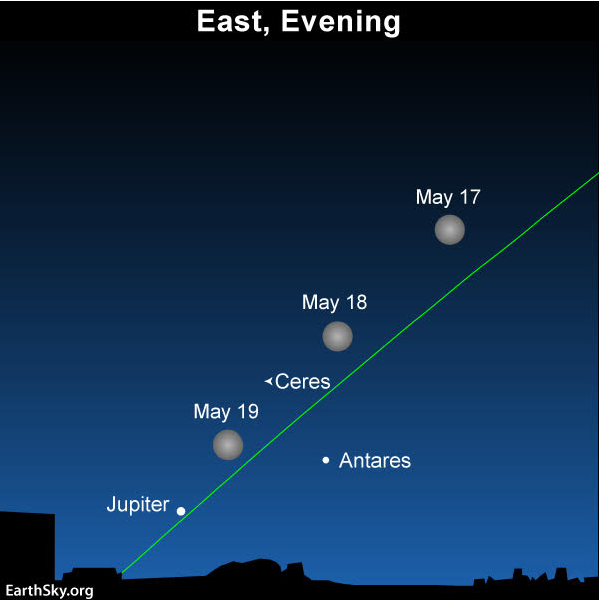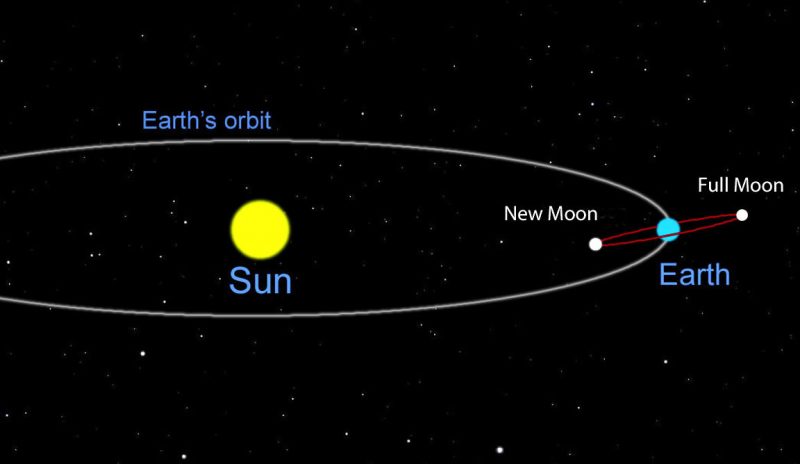

Full moon rising, by Peter Lowenstein in Mutare, Zimbabwe.
The moon appears full to the eye for two to three nights. However, astronomers regard the moon as full at a precisely defined instant, when the moon is exactly 180 degrees opposite the sun in ecliptic longitude. That full moon instant falls on May 18, 2019, at 21:11 UTC. It happens at the same moment for all of us worldwide, yet the time on our clocks vary by time zone. At Canadian and U.S. time zones, the moon turns full on May 18 at 6:11 p.m. Atlantic Time, 5:11 p.m. Eastern Time, 4:11 p.m. Central Time, 3:11 p.m. Mountain Time, 2:11 p.m. Pacific Time, 1:11 p.m. Alaskan Time and 11:11 a.m. Hawaiian Time. Translate UTC to your time zone.
Want to know the instant of full moon in your part of the world, as well as the moonrise and moonset times? Click here, remembering to check the moon phases plus moonrise and moonset boxes.
This May 18, 2019 full moon will be near a bright star, and an even-brighter planet, and it’s poised to occult an unseen object in your sky, the dwarf planet Ceres. Read more about objects near the May 18 full moon.
The May 18 full moon is also the third of four full moons in a season, in this case the season between the March equinox and June solstice. As such, it’ll be called a Blue Moon. Get the full story on Blue Moons here.

The May 18, 2019 moon full moon is near the bright star Antares, the even-brighter planet Jupiter. Less than one day after it turns full, the moon will occult, or cover over, the dwarf planet Ceres, the largest world in the asteroid belt. Read more.
Why does a full moon look full? Remember that half the moon is always illuminated by the sun. That lighted half is the moon’s day side. In order to appear full to us on Earth, we have to see the entire day side of the moon. That happens only when the moon is opposite the sun in our sky. So a full moon looks full because it’s opposite the sun.
That’s also why every full moon rises in the east around sunset – climbs highest up for the night midway between sunset and sunrise (around midnight) – and sets around sunrise. Stand outside tonight around sunset and look for the moon. Sun going down while the moon is coming up? That’s a full moon, or close to one.
Just be aware that the moon will look full for at least a couple of night around the instant of full moon.

A full moon is opposite the sun. We see all of its dayside. Illustration via Bob King.
Often, you’ll find two different dates on calendars for the date of full moon. That’s because some calendars list moon phases in Coordinated Universal Time or Universal Time Coordinated (UTC). And other calendars list moon phases in local time, a clock time of a specific place, usually the place that made and distributed the calendars. Click here to translate UTC to your local time.
If a full moon is opposite the sun, why doesn’t Earth’s shadow fall on the moon at every full moon? The reason is that the moon’s orbit is titled by 5.1 degrees with respect to Earth’s orbit around the sun. At every full moon, Earth’s shadow sweeps near the moon. But, in most months, there’s no eclipse.

A full moon normally passes above or below Earth’s shadow, with no eclipse. Illustration by Bob King.
Bottom line: Full moon – when the moon is most opposite the sun for this month – falls on May 18, 2019, at 21:11 UTC; Translate UTC to your time. As the third of four full moons in a season, it’ll be called a Blue Moon.
As the moon orbits Earth, it changes phase in an orderly way. Follow these links to understand the various phases of the moon.
New moon
Waxing crescent moon
First quarter moon
Waxing gibbous moon
Full moon
Waning gibbous moon
Last quarter moon
Waning crescent moon
Read more: 4 keys to understanding moon phases
Read more: What are the full moon names?
Source:
https://earthsky.org/moon-phases/full-moon